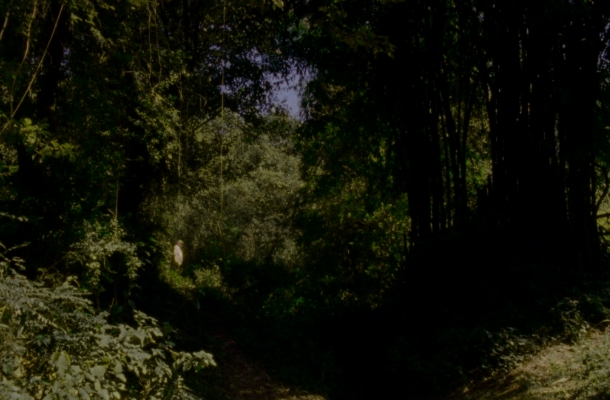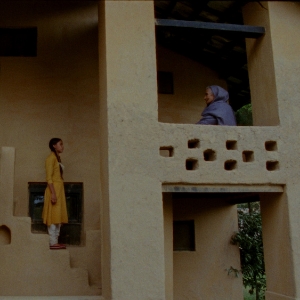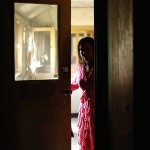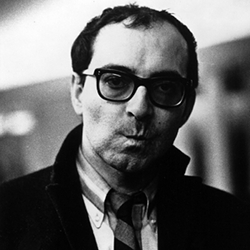
MoMA Documentary Fortnight 2014 Review: The Seventh Walk (2013) - NP Approved

Director: Amit Dutta
Country: India
Genre: Documentary
The Seventh Walk is a wistful and beautiful voyage into the world of dreams and the creative process by experimental filmmaker Amit Dutta. It is set entirely in the popular tourist landscape of the Kangra Valley and based on the art of landscape painter Paramjit Singh. In fact, Singh appears in the film as a dreamer-artist whom we follow ever deeper into a forest. What we find in the forest with Singh is a place where time operates differently; in the midst of nature, mythical time reigns and storytelling is the act of dreaming.
 The film begins with the camera discovering and going through dirt paths in the woods, so as to acquaint the spectator with the place. After a series of shots of meandering trails and lush growth, a man, Singh, appears among the trees. One is not so much startled by his sudden appearance than pleasantly delighted by it since he seems to have organically emerged from the trees, looking upwards towards them and walking along as we look at him. At this point in the film, one is more struck immediately by the gorgeous sound design of several stringed instruments and the life of the valley (the wind whistling, wings flapping, birds calling, rustling water, flies buzzing), which paint an aural equivalent to the majesty of the woods and trees as light plays with them. Even the sound of Singh’s footsteps on the uneven ground become part of the film’s aural texture in relation to the music (by Mohi Baha-ud-din Dagar), especially when leaves and twigs crackle underneath his shoes.
The film begins with the camera discovering and going through dirt paths in the woods, so as to acquaint the spectator with the place. After a series of shots of meandering trails and lush growth, a man, Singh, appears among the trees. One is not so much startled by his sudden appearance than pleasantly delighted by it since he seems to have organically emerged from the trees, looking upwards towards them and walking along as we look at him. At this point in the film, one is more struck immediately by the gorgeous sound design of several stringed instruments and the life of the valley (the wind whistling, wings flapping, birds calling, rustling water, flies buzzing), which paint an aural equivalent to the majesty of the woods and trees as light plays with them. Even the sound of Singh’s footsteps on the uneven ground become part of the film’s aural texture in relation to the music (by Mohi Baha-ud-din Dagar), especially when leaves and twigs crackle underneath his shoes.
Texture is key here: Dutta uses frequent close-ups of bark, stones, moss, water and its reflections, and tree roots, among others, to convey the living organism that is this place. At the same time, the close-ups make them abstract and unfamiliar. In this way, The Seventh Walk is as much about perception as it is about vision. Singh finds footprints and picks up a stone from the pond, prompting him to follow the trail of this unknown person. In a lovely long shot, Dutta captures Singh arriving at a most regal tree caught and sitting at its feet. Cut to a low angle of him seated against the tree, with his back and head parallel to its vertical height, and it is almost as if he becomes part of it; so much so, perhaps, that he disappears. Where to? We find him in a different part of the forest; more importantly, he is now also in a different plane of being and creating, where bottles and stones hover above the ground by themselves and he begins to work.
Dutta’s choice of measured camera movement (lateral tracking, zoom-ins, zoom-outs) that recalls the films of Andrei Tarkovsky contributes to this sense of a different plane of being and creating. In a house revealed hidden among the growth, Singh sets about sketching with charcoal. Dutta’s manner of presenting Singh at work weds drawing and painting very closely with nature. For example, the scratchy sound of the charcoal on paper becomes ever faster according to what Singh is drawing, but at the same time it comes to sound like something else, as images of luscious grass fill the screen instead of what Singh is actually drawing. Dutta continues to pair multiple varieties of growth with Singh’s drawings and, later, paintings. Another example of this pairing are the images of trees accompanied by the sounds of Singh’s spatula hitting the canvas. When finally shown, Singh’s drawings and paintings are moving in their simplicity and air of forlorn mystery (similar to the feel of Giorgio DiChirico’s ‘metaphysical’ paintings, actually). But as with the various aspects of the forest, Dutta also abstracts Singh’s works by bringing his camera ever closer to them so that the figures or landscapes depicted fade into view and all that remains is a grainy surface of oil on canvas.
Dutta uses frequent close-ups of bark, stones, moss, water and its reflections, and tree roots, among others, to convey the living organism that is this place.
Inversely, Dutta captures Singh at work on a canvas, with the camera very close to it. At first glance, it does not look like anything because one is so close to it. But gradually, as the camera pulls back in relation to Singh continuing with the painting: trees, then a river, then rain falling on the river, and then snow appear, enhanced by the aural accompaniment of nature’s sounds. Furthermore, Dutta employs some cinematic magic tricks to make small and large stones jump out of the water and hover above the ground to couple with a number of Singh’s paintings that contain such stones within landscapes. In this way, Dutta composes an extraordinary sensual work on the very abstract process of artistic creation and inspiration, regarding not just Singh but also himself. Dutta sets his imaginative vision and perception against those of the camera eye, and against those of Singh, or better yet, puts them all in dialogue with each other.
The Seventh Walk is simply magnetic and mysterious in its dream quality, like a song with its tonal highs and lows, and resists easy categorisation of documentary or fiction. It more than expresses why Dutta is considered one of the foremost filmmakers working in experimental cinema today; it convinces us.
Related Posts
![]()
Rowena Santos Aquino
![]()
Latest posts by Rowena Santos Aquino (see all)



























